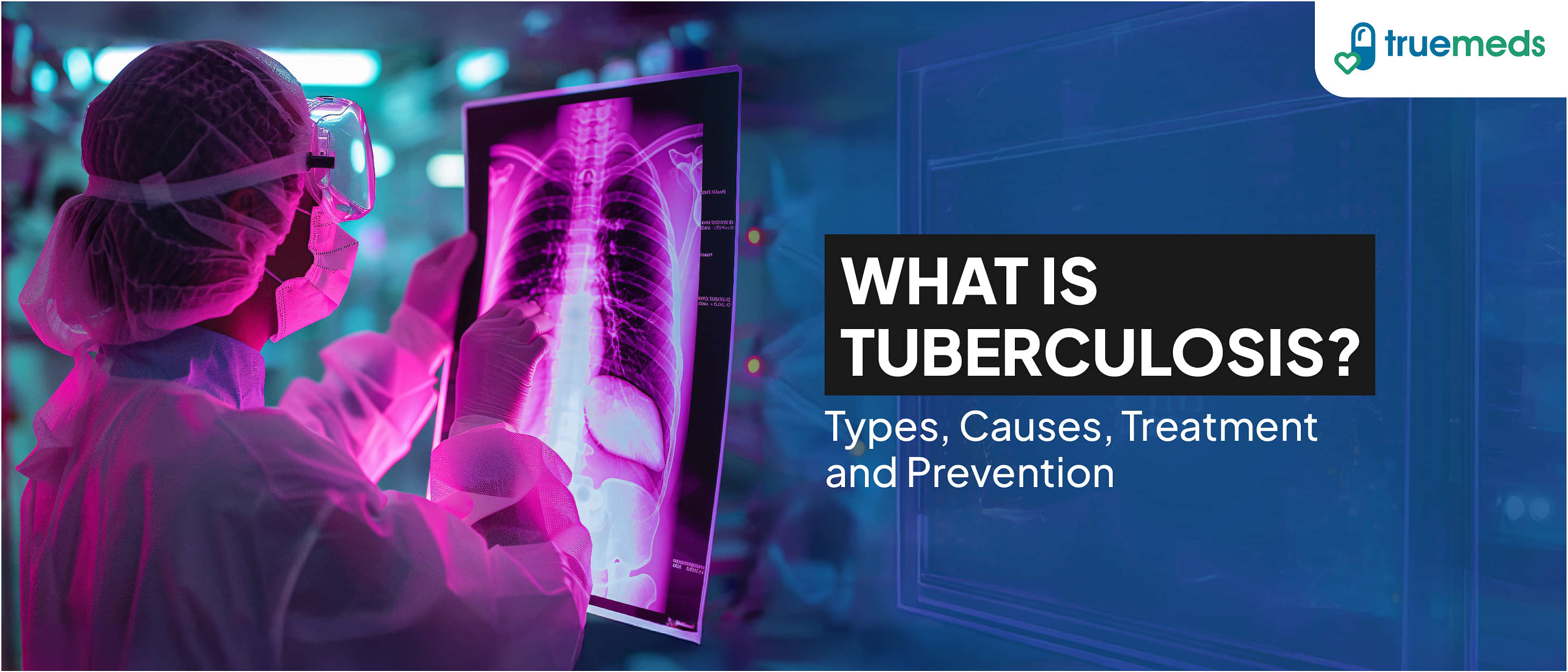What is Tuberculosis: Types, Causes, Treatment And Prevention
Last updated on : 30 Oct, 2024
Read time : 9 min
Introduction
Tuberculosis, commonly known as TB, is a potent infectious disease that primarily affects the lungs but can also impact other parts of the body. Understanding the different types of tuberculosis is crucial for effective treatment and prevention. This bacterial disease has been a significant health challenge globally for centuries, affecting millions of people worldwide. As we delve deeper into the subject, it’s important to understand what TB is and how it impacts our bodies.
| Did You Know? TB has been around for thousands of years. Evidence of TB has been found in Egyptian mummies dating back to 2400 BC. |
What is Tuberculosis?
Tuberculosis (TB) is a contagious disease caused by the bacterium Mycobacterium tuberculosis. It mainly targets the lungs, leading to what’s commonly known as ‘pulmonary tuberculosis’. However, it can also affect other organs like the brain, kidneys, and spine. This makes understanding the different types of TB critical for effective diagnosis and treatment.
TB spreads through the air when an infected person coughs, sneezes, or talks, releasing tiny droplets containing the bacteria into the atmosphere. Thus, anyone in close proximity can inhale these droplets and potentially get infected.
While TB can infect anyone regardless of age or health status, certain populations are at a higher risk. For example, individuals with weakened immune systems or those living in crowded conditions are more prone to contracting the disease.
Did You Know?
TB can present in two forms:
- Latent TB: Here, the bacteria remain inactive within the body without causing symptoms. While this form isn’t contagious, it can turn into active TB if not treated properly.
- Active TB: In contrast to latent TB, this form is both symptomatic and contagious.
Prompt detection and treatment are crucial as untreated TB can lead to severe health complications and even death. Despite being preventable and curable, TB remains one of the leading causes of death from infectious diseases worldwide.
Types of Tuberculosis
Tuberculosis takes various forms based on its location and symptoms. The primary types we commonly see are as follows:
1) Pulmonary Tuberculosis
Pulmonary tuberculosis is a type of TB that primarily affects the lungs. It’s the most common form of tuberculosis, and its symptoms often include a persistent cough, chest pain, and occasionally coughing up blood. It spreads through the air when an infected person breathes out, making it a highly contagious type of TB. Prompt diagnosis and treatment are crucial in preventing its spread and managing its complications.
2) Extrapulmonary Tuberculosis
Extrapulmonary tuberculosis is a type of TB that occurs outside the lungs, commonly affecting lymph nodes, bones, kidneys, or even the brain. The symptoms vary depending on which part of the body is affected but may include fever, weight loss, and localised pain. This form of TB is less contagious than pulmonary tuberculosis but can be quite severe, warranting immediate medical attention.
3) Latent Tuberculosis
In latent tuberculosis, the bacteria remain inactive in the body without causing any noticeable symptoms. Yet people with this latent form of TB are at risk of developing an active infection later on, particularly if their immune system weakens due to other health issues. Thus, treatment for latent TB is vital to prevent potential outbreaks and safeguard public health.
What Causes Tuberculosis?
Knowing what causes tuberculosis is essential for effective prevention and control measures.
1) Bacterial Agent
Mycobacterium tuberculosis, the bacterium causing TB, thrives in oxygen-rich environments like our lungs. It’s a slow-growing aerobic organism with a complex cell wall structure that resists many antibiotics. This resistance complicates the treatment process. The bacterium’s adaptability allows it to survive in diverse conditions, making it the primary agent for TB infections.
| Did You Know? TB bacteria can become resistant to antibiotics through genetic mutations. Multidrug-resistant TB (MDR-TB) and extensively drug-resistant TB (XDR-TB) are major public health threats. |
2) Transmission
Tuberculosis mainly spreads through the air when an infected person coughs, sneezes, or even talks, releasing infectious droplets into the surroundings. These droplets can stay suspended in the air for several hours, creating a risk for others nearby. The chances of transmission increase with prolonged exposure in confined spaces, emphasising the importance of promptly identifying and treating infected individuals.
Risk Factors
Several factors can increase one’s risk of contracting tuberculosis. These include possessing a weakened immune system due to conditions like HIV/AIDS, living in crowded or poorly ventilated environments, and having close contact with someone who has active TB. Certain demographics, such as young children and the elderly, are more susceptible to severe forms of the disease. Understanding these risk factors can help devise effective prevention strategies.
Treatment of Tuberculosis
Contrary to popular belief, tuberculosis is curable. The cornerstone of treating this ailment is a combination of antibiotics, administered over a prolonged period. The duration of the treatment and types of drugs used can vary depending on the type and severity of the infection.
1) Medications
The primary medications used to combat TB are isoniazid, rifampicin, ethambutol, and pyrazinamide. These potent antibiotics work synergistically to obliterate the bacteria from your system and prevent them from developing resistance. Adherence to the prescribed regimen is of utmost importance. Any lapse may lead to a much-dreaded form called drug-resistant TB, which poses a bigger challenge to treat and incurs significant costs.
| Did You Know? Certain foods and herbs have been used historically to treat TB, including garlic, onions, turmeric, and cod liver oil. However, their effectiveness has not been scientifically proven. |
2) Treatment Regimen
Typically, a treatment regimen for active TB lasts six to nine months. It involves an initial two-month period, known as the ‘intensive phase,’ where patients take multiple medications daily. This stage is followed by a ‘continuation phase,’ where fewer medications are administered over the remaining period. Regular monitoring by your doctor along with follow-up appointments is essential to ensure that the treatment is effective and dosage instructions are strictly followed.
Managing Side Effects
Patients undergoing TB treatment may experience side effects such as nausea, fatigue, or liver toxicity from the prescribed medications. It’s paramount for doctors to enlighten patients about potential side effects and guide them on how to manage these discomforts. Regular blood tests are usually undertaken to monitor liver function and overall health, ensuring any adverse effects are addressed promptly.
Prevention of Tuberculosis
Prevention is as important as treatment in controlling the spread of TB and safeguarding public health. This involves strategic vaccination programs, implementation of public health measures, and encouraging individual preventive actions.
1) Vaccination
The Bacillus Calmette-Guérin (BCG) vaccine, named after its creators, is primarily used to prevent TB, especially in children. Although it doesn’t offer complete protection against pulmonary TB – the most common type of TB affecting the lungs, it significantly reduces the risk of severe forms, such as TB meningitis. Vaccination has become indispensable in high-risk populations and regions with a high prevalence of TB.
| Did You Know? The BCG vaccine, used to prevent severe forms of TB, was first administered in 1921. It is one of the most widely used vaccines in the world. However, the BCG vaccine is not very effective in preventing pulmonary TB in adults. Research is ongoing to develop new, more effective TB vaccines. |
2) Preventive Measures
There are several preventive steps that individuals can adopt to reduce their risk of contracting TB. These include ensuring good ventilation in homes and workplaces, practising good respiratory hygiene (like covering your mouth when coughing or sneezing), and avoiding close contact with individuals known to have active TB. Regular health check-ups and screenings for high-risk groups can also aid in early detection and prevention.
3) Public Health Measures
Public health measures are the fulcrum of any successful TB prevention strategy. These involve widespread screening programs, meticulous contact tracing, and robust education campaigns to raise awareness about TB transmission and symptoms. Government bodies and health organisations must improve access to healthcare facilities, ensuring prompt diagnosis and treatment for all – a vital step towards reducing the incidence of TB in the community.
Also Read: Tuberculosis Diet: What Food You Should Eat and Avoid
Conclusion
TB, in its various forms, remains a formidable health challenge not only in India but globally. Understanding the nuances of this disease, be it pulmonary tuberculosis or any other type, is a significant step towards combating this infectious ailment.
The journey of curing TB begins with correct and timely diagnosis. Once diagnosed, an effective treatment regimen involving antibiotics can help cure active TB, considerably reducing its adverse impact on individuals and societies.
Preventive measures are equally important in controlling the spread of TB. These measures involve vaccination programmes against TB and various public health initiatives that specifically target high-risk populations such as prisoners, healthcare workers, and people living in close quarters.
Education plays a pivotal role in this fight against TB. By raising awareness about the different types of TB and promoting education on its causes, symptoms and treatment, we can foster a more proactive approach to health among people. This would ensure those at risk receive appropriate care and support promptly.
| Did You Know? The first World TB Day was celebrated on March 24, 1982, the 100th anniversary of Dr. Robert Koch’s announcement of his discovery of the TB bacillus in 1882. |
FAQs
Tuberculosis (TB) has two main types: latent tuberculosis and active tuberculosis. Depending on the affected organ, it is also classified as pulmonary or extra-pulmonary TB.
Prevention of TB involves methods such as BCG vaccination, timely diagnosis, and treatment of latent TB, and promoting good hygiene practices.
Treatment for TB prevention typically includes a regimen of antibiotics prescribed by a doctor, often involving medication like isoniazid or rifampicin.
The main cause of TB is the bacterium Mycobacterium tuberculosis. It spreads through the air when an infected person coughs or sneezes.
Disclaimer
Our healthcare experts have carefully reviewed and compiled the information presented here to ensure accuracy and trustworthiness. It is important to note that this information serves as a general overview of the topic and is for informational purposes only. It is not intended to diagnose, prevent, or cure any health problem. This page does not establish a doctor-patient relationship, nor does it replace the advice or consultation of a registered medical practitioner. We recommend seeking guidance from your registered medical practitioner for any questions or concerns regarding your medical condition.
Popular Articles
Recommended Articles
Recent Articles
Top-Selling Medicines:
...View more
Top-Selling OTC:
...View more
Subscribe
Claim your complimentary health and fitness tips subscription and stay updated on our newest promotions.
Download Truemeds
Manage your health with ease Download Truemeds today!Get easy access to medicine refills, health information, and more. With our app, you'll never have to wait in line again. Download now and start taking control of your health.

Contact Us
Our customer representative team is available 7 days a week from 9 am - 9 pm.
v3.5.0
Our Payment Partners



























































